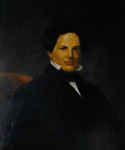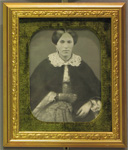30 September 2005 – 10 February 2006
E.S. Bird Library, 6th floor
Viewing Hours: Monday - Friday, 9 a.m. to 5 p.m.
Introduction
During the decades-long struggle to abolish slavery, thousands of African Americans risked their lives to escape from their bitter bondage in the South to seek freedom in the northern states, or beyond in Canada. One by one or in small groups, slaves were aided in their perilous journeys by a clandestine network of fellow African Americans and sympathetic whites that came to be known as the Underground Railroad.
Syracuse served as an important station along this freedom trail because of its central location on the Erie Canal and its associated waterways and travel routes. Central New York was also home to many of the most outspoken and defiant opponents of slavery. Jermain Loguen, himself a refugee from slavery, publicized the address of his home at East Genesee and Pine streets as a shelter. He sought and obtained support for his efforts from local abolitionists and reformers, such as Matilda Joslyn Gage and Samuel J. May. Gerrit Smith, from nearby Peterboro, applied his considerable wealth and influence to advancing antislavery activities in Syracuse through public debate, published tracts, direct aid, and daring acts of civil disobedience.
The passage by Congress in September 1850 of the Fugitive Slave Law—which made interfering with the slaveowner’s right to recover his “property” a federal crime with severe penalties—virtually guaranteed that dramatic conflicts would arise between those who sought to end slavery and those who tolerated the compromises that allowed it to continue. Resistance and conflict had already been brewing for some time in Syracuse, as demonstrated by the case of Harriet Powell in 1839 and others, prompting Secretary of State Daniel Webster in May 1851 to brand the city a “laboratory of abolitionism, libel, and treason.”
Webster’s characterization was apt. Within a few months, a large crowd would storm a municipal jail to free a fugitive slave who had been apprehended by means of the controversial law. The famous “Jerry Rescue” became a potent symbol and rallying cry for Gerrit Smith the following year when he was elected to Congress and for the abolitionist movement in this region.
This exhibition organized by Syracuse University Library vividly documents the flourishing antislavery activism in Syracuse and the surrounding communities during the period between the 1830s and the 1850s. We have gathered original artifacts housed in the library’s Special Collections Research Center along with items on loan from the Matilda Joslyn Gage Foundation, the Howard University Gallery of Art, the Madison County Historical Society, and the Onondaga Historical Association.
The exhibition is presented in conjunction with this year’s Syracuse Symposium and its theme of “borders.” We gratefully acknowledge the financial support of the Kaleidoscope Project, a diversity initiative between the Divisions of Undergraduate Studies and Student Affairs to broaden the understanding of diversity and promote healthy dialogue about related issues at Syracuse University. Additional funding has been provided by the College of Arts and Sciences and the Warren and Edith Day Fund of Syracuse University Library.
On 2 October 1851, the day after the Jerry Rescue, Gerrit Smith proposed the following resolution condemning Daniel Webster for his outspoken support of the Fugitive Slave Act of 1850, and it was adopted at the Liberty Party convention:
Whereas, Daniel Webster, That base and infamous enemy of the human race, did in a speech of which he delivered himself, in Syracuse last Spring, exultingly and insultingly predict that fugitive slaves would yet be taken away from Syracuse and even from anti-slavery conventions in Syracuse, and whereas the attempt to fulfill this prediction was delayed until the first day of October, 1851, when the Liberty party of the State of New York were holding their annual convention in Syracuse; and whereas the attempt was defeated by the mighty uprising of 2,500 brave men, before whom the half-dozen kidnappers were “as tow,” therefore,
Resolved, That we rejoice that the City of Syracuse—the anti-slavery city of Syracuse—the city of anti-slavery conventions, our beloved and glorious city of Syracuse—still remains undisgraced by the fulfillment of the satanic prediction of the satanic Daniel Webster.
Portraits of Local Abolitionists and Reformers
Oil portrait (ca. 1855) of the Reverend Samuel J. May, one of Central New York’s most active abolitionists and reformers, by Sanford Thayer. Courtesy of the Onondaga Historical Association Museum and Research Center, Syracuse, N.Y.
Lithograph (ca. 1854) of Gerrit Smith, one the most prominent American reformers and philanthropists of the nineteenth century. Courtesy of the Madison County Historical Society.
Marble sculpture of the clasped hands of Gerrit and Ann Smith. This was created as a token of esteem by an escaped slave who credited the Smiths with his freedom. Courtesy of the Madison County Historical Society.
Oil portrait (1854) of Jermain W. Loguen, the chief agent of the Underground Railroad in Syracuse, by African American artist William H. Simpson. Courtesy of the Howard University Gallery of Art.
Photographic image of Matilda Joslyn Gage, the women’s rights advocate and abolitionist of Fayetteville, New York. The Gage home became one of two stops in Fayetteville on the Underground Railroad when Matilda Joslyn Gage responded to the call of the Reverend Jermain Loguen for assistance, and this official status has been confirmed by both the National Park Service and the State of New York. This framed image is on loan from the Matilda Joslyn Gage Foundation.
Photographic image of Dr. Hezekiah Joslyn, the father of Matilda Joslyn Gage and a founding member of the radical abolitionist Liberty Party. This framed image is on loan from the Matilda Joslyn Gage Foundation.
Daguerreotype image of the Cazenovia Fugitive Slave Law Convention held on 21 and 22 August 1850. Even before its passage into law in September of 1850, there was a tremendous outpouring of opposition to the Fugitive Slave Law. This federal act permitted the apprehension of escaped slaves even in the free states of the North and provided for serious fines and terms of imprisonment for anyone obstructing the implementation of the law. Among the participants in this gathering in Cazenovia were Gerrit Smith (the man with the outstretched arm in the center), Mary and Emily Edmonson (to the right and left of Gerrit Smith, respectively), Frederick Douglass (seated at the table just to the right of Gerrit Smith), and Samuel J. May (standing immediately behind the man who is writing at the table). This image taken by Ezra Greenleaf Weld, the brother of Theodore Weld, a leading abolitionist, is provided courtesy of the Madison County Historical Society, the repository that owns the original daguerreotype.
Photograph of the Matilda Joslyn Gage House in Fayetteville, New York, taken by L. Frank Baum, the son-in-law of Gage and the author of The Wizard of Oz. As the newspaper account in this case describes, Matilda Joslyn Gage offered her home as one of the local stops on the section of the Underground Railroad overseen by the Reverend Jermain Loguen. The photograph appears courtesy of the Matilda Joslyn Gage Foundation.
Letter from Matilda Joslyn Gage to Gerrit Smith, 24 June 1869. It demonstrates the close network of reformers and reform movements that existed in the greater Syracuse area in the mid-nineteeth century. Gerrit Smith was the first cousin of Elizabeth Cady, a leader in the women’s suffrage movement, and Cady married the abolitionist Henry Stanton after having met him while visiting the Smith household. Mrs. Gage reminds Smith that she is the daughter of Dr. Hezekiah Joslyn, his friend and a fellow abolitionist and member of the Liberty Party. She also assures Smith that the Reverend Samuel J. May is wholeheartedly behind their program of woman’s suffrage but is in Boston working on Some Recollections of Our Antislavery Cause, a book with which Smith was quite familiar because he was being consulted about it by May in the letter that is adjacent to the volume in this exhibit.
You have probably been made aware through your daughter, or Mrs Stanton, of the organization of the National Woman’s Suffrage Ass[ociation]. and of the design of holding a State convention at Saratoga in July for the purpose of effecting our organization of the state.
We are very anxious to obtain the names of friends of the reform in the various Congressional Districts of the State with whom we can correspond, in order to insure a full delegation at that time.
Mr Hammond, formerly pastor of the Free Church in Peterborough, suggested that as many of the old liberty party men were also advocates of this reform, you might be able to give me a list of persons to whom it would be desirable to write. I would like the names of one or two persons, men or women, in the various Congressional districts, whom you know, or think to be in favor of women’s suffrage....
Will you not go as delegate, from your district?
You will perhaps recall me to mind as the daughter of your old friend Dr Joslyn, late of Syracuse.
Mr May is with us heart and mind, but I regret to say will be in Boston the most, if not all of, July, on business connected with his book.
Speech of Mrs. M. E. J. Gage, at the Women’s Rights Convention, Held at Syracuse, September, 1852. This pamphlet is on loan from the Onondaga Historical Association Museum and Research Center in Syracuse, N.Y., and makes a clear allusion to the tradition of local reform movements and almost certainly the Jerry Rescue: “Let Syracuse sustain her name for radicalism.”
May 1880 issue of the National Citizen and Ballot Box (vol. five, no. one). Matilda Joslyn Gage, the editor, published in this issue of the Syracuse newspaper a recollection of her involvement in the Underground Railroad through the outreach efforts of the Reverend Jermain Loguen:
Many of us recall the fugitive slave law of a few years since, when we northern people, all were forbidden under severe penalty to give an escaping slave from the South, either food, or shelter, or a drink of cold water. The humanity of the country rose against it, and although many people broke the law silently, few dared defy it openly. One of the proudest acts of my life, one that I look back upon with most satisfaction is that when Rev. Mr. Lougen [sic] of this city went to the village of my residence to ascertain the names of those upon whom run-away slaves might depend for aid and comfort on their way to Canada, I was one of the two solitary persons who gave him their names. Myself and one gentleman of Fayetteville, were the only two persons who dared thus publicly defy “the law” of the land, and for humanity’s sake render ourselves liable to fine and imprisonment in the county jail, for the crime of feeding the hungry, giving shelter to the oppressed, and helping the black slave on to freedom.
Chair (ca. 1852) made by William “Jerry” Henry in Kingston, Ontario, following his escape from jail during the celebrated Jerry Rescue in Syracuse on 1 October 1851. Courtesy of the Onondaga Historical Association Museum and Research Center, Syracuse, N.Y.













